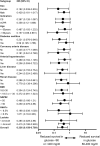Admission blood glucose level and outcome in patients requiring venoarterial extracorporeal membrane oxygenation
- PMID: 33944987
- PMCID: PMC8405505
- DOI: 10.1007/s00392-021-01862-7
Admission blood glucose level and outcome in patients requiring venoarterial extracorporeal membrane oxygenation
Abstract
Background: Patients with cardiogenic shock or cardiac arrest undergoing venoarterial extracorporeal membrane oxygenation (V-A ECMO) frequently present with blood glucose levels out of normal range. The clinical relevance of such findings in the context of V-A ECMO is unknown. We therefore investigated the prognostic relevance of blood glucose at time of cannulation for V-A ECMO.
Methods: We conducted a single-center retrospective registry study. All patients receiving V-A ECMO from October 2010 to January 2020 were included if blood glucose level at time of cannulation were documented. Patients were divided in five groups according to the initial blood glucose level ranging from hypoglycemic (< 80 mg/dl), normoglycemic (80-140 mg/dl), to mild (141-240 mg/dl), moderate (241-400 mg/dl), and severe (> 400 mg/dl) hyperglycemia, respectively. Clinical presentation, arterial blood gas analysis, and survival were compared between the groups.
Results: 392 patients met inclusion criteria. Median age was 62 years (51.5-70.0), SAPS II at admission was 54 (43.5-63.0), and 108/392 (27.6%) were female. 131/392 were discharged alive (hospital survival 33.4%). At time of cannulation, survivors had higher pH, hemoglobin, calcium, bicarbonate but lower potassium and lactate levels compared to non-survivors (all p < 0.01). Outcome of patients diagnosed with particularly high (> 400 mg/dl) and low (< 80 mg/dl) blood glucose at time of V-A ECMO cannulation, respectively, was worse compared to patients with normoglycemic, mildly or moderately elevated values (p = 0.02). Glucose was independently associated with poor outcome after adjustment for other predictors of survival and persisted in all investigated subgroups.
Conclusion: Arterial blood glucose at time of V-A ECMO cannulation predicts in-hospital survival of patients with cardiac shock or after ECPR. Whether dysglycemia represents a potential therapeutic target requires further evaluation in prospective studies.
Keywords: Cardiogenic shock; ECPR; Glucose; Survival; V-A ECMO.
© 2021. The Author(s).
Conflict of interest statement
AS reports research grants and lecture fees from CytoSorbents and lecture fees from Abiomed, both outside the submitted work. The other authors declare that they have no competing interests.
Figures




References
-
- Duerschmied D, Zotzmann V, Rieder M, Bemtgen X, Biever PM, Kaier K, et al. Myocardial infarction type 1 is frequent in refractory out-of-hospital cardiac arrest (OHCA) treated with extracorporeal cardiopulmonary resuscitation (ECPR) Sci Rep. 2020;10:8423. doi: 10.1038/s41598-020-65498-9. - DOI - PMC - PubMed
-
- Beiser DG, Carr GE, Edelson DP, Peberdy MA, Hoek TLV. Derangements in blood glucose following initial resuscitation from in-hospital cardiac arrest: a report from the national registry of cardiopulmonary resuscitation. Resuscitation. 2009;80:624–630. doi: 10.1016/j.resuscitation.2009.02.011. - DOI - PMC - PubMed
MeSH terms
Substances
LinkOut - more resources
Full Text Sources
Medical
Miscellaneous

